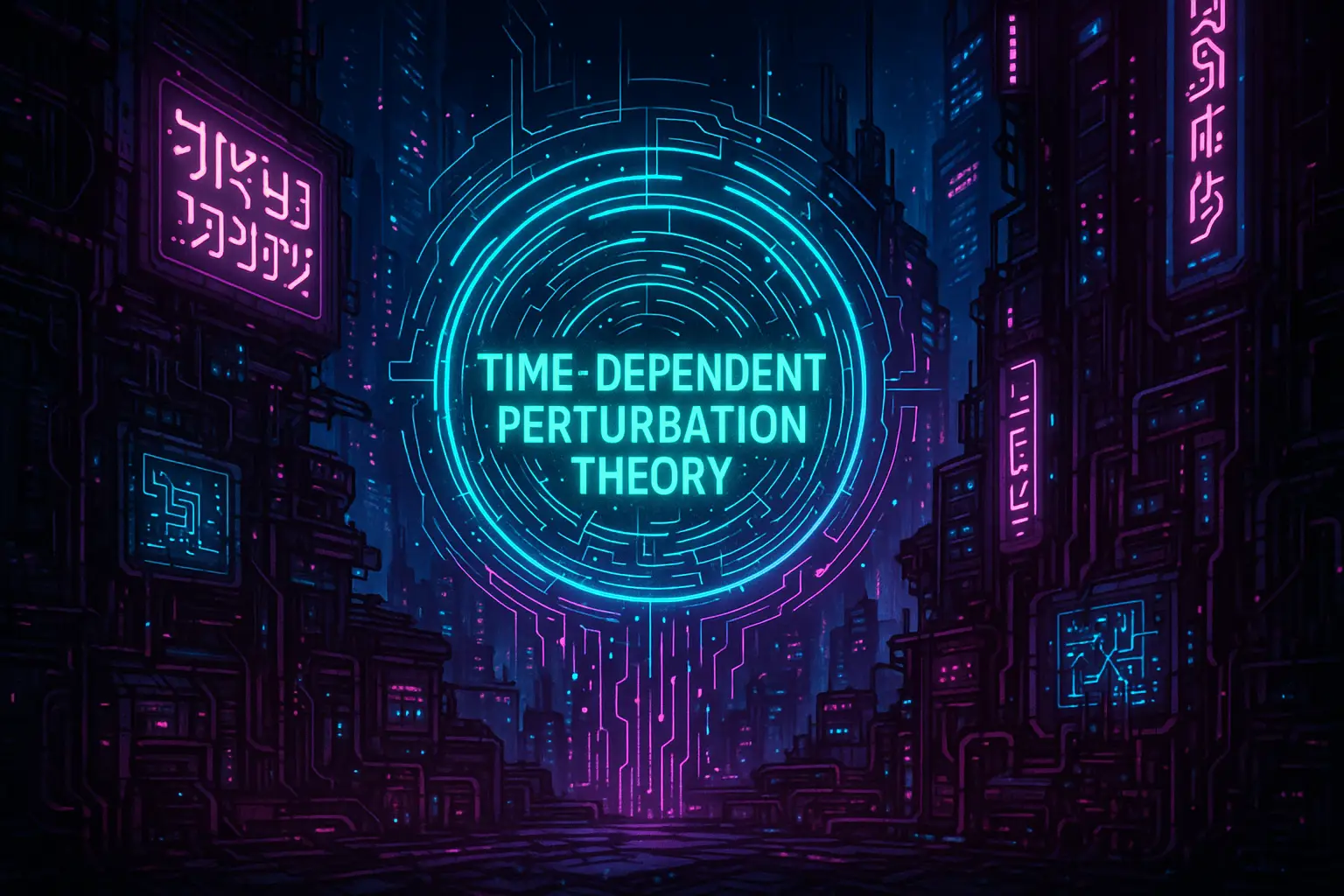Table of Contents
- Introduction
- Motivation and Relevance
- General Setup of Time-Dependent Perturbation
- The Interaction Picture
- First-Order Time-Dependent Perturbation Theory
- Transition Probabilities
- Fermi’s Golden Rule
- Periodic Perturbations and Resonance
- Example: Two-Level Atom in an Oscillating Field
- Sudden and Adiabatic Perturbations
- Transition Amplitudes and Matrix Elements
- Harmonic Perturbations and Selection Rules
- Applications in Quantum Optics
- Limitations and Cautions
- Conclusion
1. Introduction
Time-dependent perturbation theory is used in quantum mechanics to study how a quantum system evolves when its Hamiltonian changes with time. While time-independent perturbation theory handles stationary systems, many important physical phenomena involve time-varying interactions, such as electromagnetic fields or sudden kicks.
2. Motivation and Relevance
This theory is crucial for understanding:
- Absorption and emission of light.
- Atomic transitions and decay processes.
- Response to external fields in quantum optics.
- Particle scattering and time-dependent forces.
3. General Setup of Time-Dependent Perturbation
We split the Hamiltonian as:
\[
\hat{H}(t) = \hat{H}_0 + \hat{H}'(t)
\]
where:
- \( \hat{H}_0 \): Time-independent part with known solutions.
- \( \hat{H}'(t) \): Time-dependent perturbation, assumed small.
We expand the wavefunction in the eigenbasis of \( \hat{H}_0 \):
\[
|\psi(t)\rangle = \sum_n c_n(t) e^{-i E_n t/\hbar} |n\rangle
\]
4. The Interaction Picture
To simplify calculations, we use the interaction picture, where operators evolve like in the Heisenberg picture but states evolve under the perturbation:
\[
i\hbar \frac{d}{dt} |\psi_I(t)\rangle = \hat{H}’_I(t) |\psi_I(t)\rangle
\]
with:
\[
\hat{H}’_I(t) = e^{i\hat{H}_0 t/\hbar} \hat{H}'(t) e^{-i\hat{H}_0 t/\hbar}
\]
5. First-Order Time-Dependent Perturbation Theory
We solve the differential equation perturbatively. The first-order transition amplitude from state \( |i\rangle \) to \( |f\rangle \) is:
\[
c_f^{(1)}(t) = \frac{1}{i\hbar} \int_{0}^{t} \langle f | \hat{H}'(t’) | i \rangle e^{i\omega_{fi} t’} dt’
\]
Where \( \omega_{fi} = (E_f – E_i)/\hbar \).
6. Transition Probabilities
The probability of transitioning from \( |i\rangle \) to \( |f\rangle \) is:
\[
P_{i \rightarrow f}(t) = |c_f^{(1)}(t)|^2
\]
This gives us measurable quantities like decay rates and absorption strengths.
7. Fermi’s Golden Rule
For perturbations that are constant in time or turned on suddenly, and observed over long times:
\[
P_{i \rightarrow f}(t) \approx \frac{2\pi}{\hbar} |\langle f | \hat{H}’ | i \rangle|^2 \rho(E_f)
\]
Here \( \rho(E_f) \) is the density of final states. This rule is crucial in particle and nuclear physics.
8. Periodic Perturbations and Resonance
For oscillatory perturbations:
\[
\hat{H}'(t) = \hat{V} \cos(\omega t)
\]
Transitions are enhanced (resonant) when:
\[
\hbar \omega = E_f – E_i
\]
This underpins spectroscopy, lasers, and resonance phenomena in quantum systems.
9. Example: Two-Level Atom in an Oscillating Field
A system with two states \( |g\rangle \) and \( |e\rangle \), interacting with an external electric field:
\[
\hat{H}'(t) = \hbar \Omega \cos(\omega t)(|g\rangle \langle e| + |e\rangle \langle g|)
\]
Time-dependent perturbation theory predicts Rabi oscillations and transition probabilities dependent on detuning and field strength.
10. Sudden and Adiabatic Perturbations
- Sudden: Perturbation changes faster than the system’s natural time scale. The wavefunction remains unchanged but expands in the new eigenbasis.
- Adiabatic: Perturbation changes slowly, and the system adapts continuously, staying in the instantaneous eigenstate.
These are limits used in both analytic calculations and quantum control.
11. Transition Amplitudes and Matrix Elements
The core quantity is:
\[
\langle f | \hat{H}'(t) | i \rangle
\]
which determines how “connected” the initial and final states are. Strong matrix elements lead to high transition rates.
12. Harmonic Perturbations and Selection Rules
Perturbations like:
\[
\hat{H}'(t) = q E_0 x \cos(\omega t)
\]
lead to dipole transitions. The selection rules are derived from symmetry and parity considerations. E.g., \( \Delta \ell = \pm 1 \), \( \Delta m = 0, \pm 1 \) in atoms.
13. Applications in Quantum Optics
- Stimulated emission and absorption.
- Laser physics and coherent control.
- Photon-atom interaction in cavity QED.
- Nuclear magnetic resonance (NMR) and electron spin resonance (ESR).
14. Limitations and Cautions
- Assumes perturbation is small compared to level spacing.
- Higher-order effects can be significant in strong fields.
- Breakdown near level crossings and avoided crossings.
- Doesn’t account for dissipation or decoherence unless extended.
15. Conclusion
Time-dependent perturbation theory is a foundational tool in quantum mechanics that allows physicists to analyze transitions between quantum states under external influences. From understanding atomic spectra to designing quantum control protocols, it plays a central role in both theoretical and experimental quantum science.


